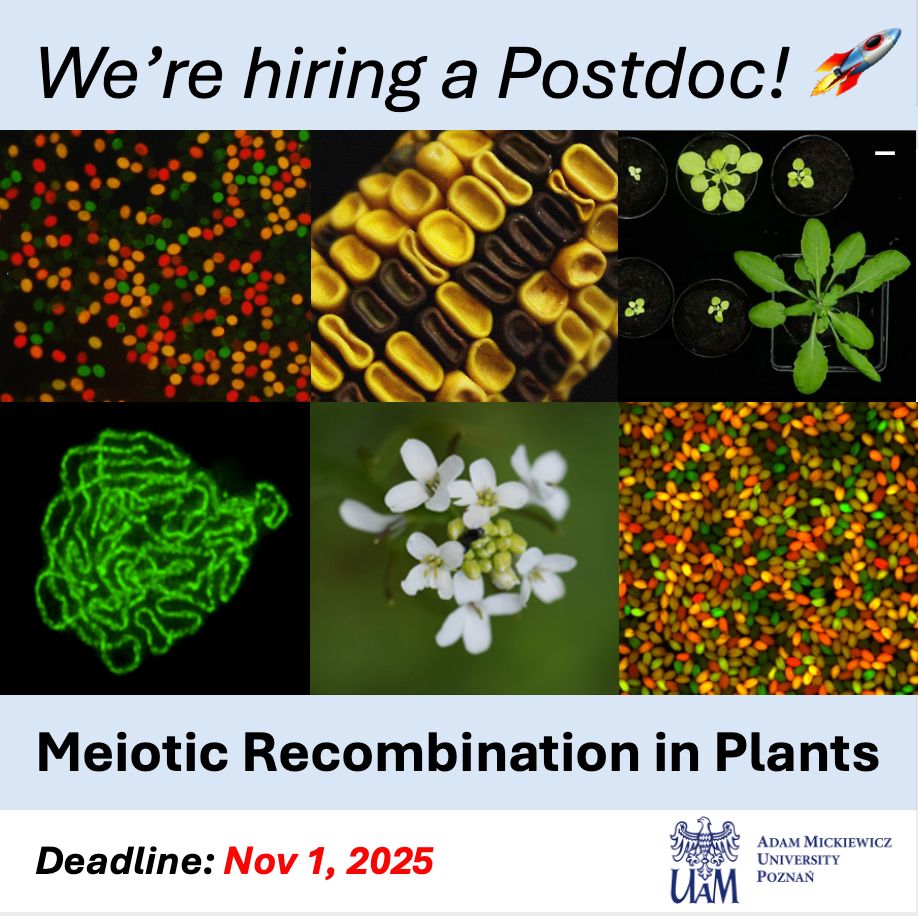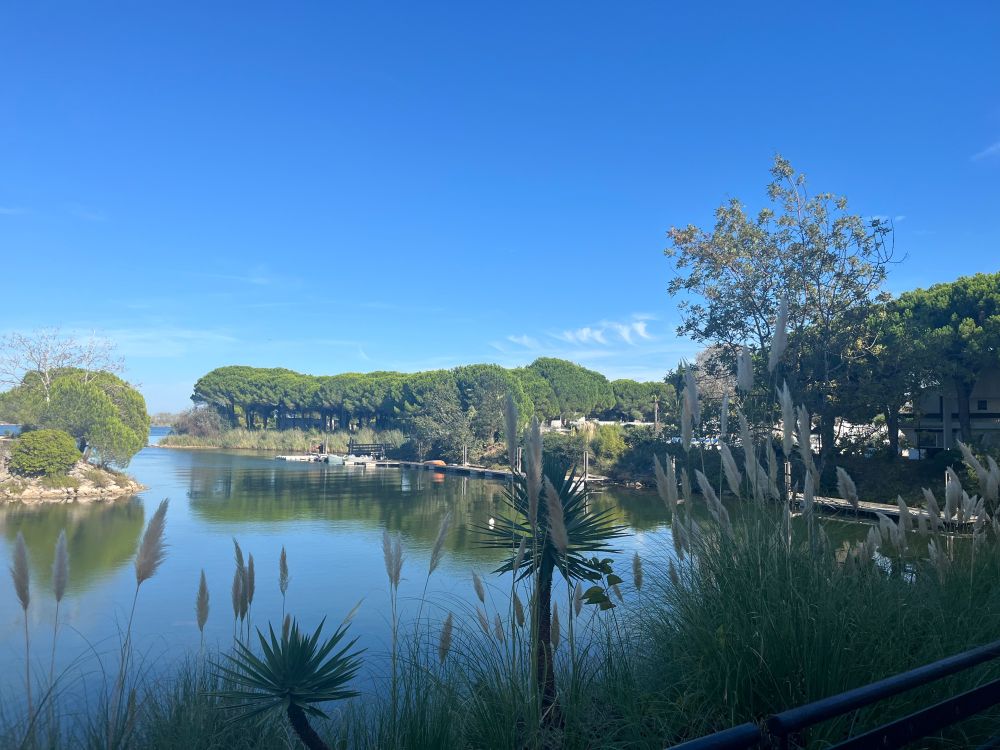Come join the workshop!
Apply here: evomics.org/apply-worksh...
bsky.app/profile/jlst...
Eva Dvorak Tomastikova
@evadt.bsky.social
Scientist working on DNA damage repair in plants Chromatin organization and function group of Aleš Pečinka
@evadt.bsky.social
Scientist working on DNA damage repair in plants Chromatin organization and function group of Aleš Pečinka
Come join the workshop!
Apply here: evomics.org/apply-worksh...
bsky.app/profile/jlst...

🧬✨ It’s official!
EMPSEB31 is coming to Germany, June 2026!
Europe’s friendliest evolution meeting returns, organized by PhD students, for PhD students.
Expect inspiring research, new connections, and a mix of science + fun, the EMPSEB way!
📍Save the date & follow us for updates! Link in Bio 🌍

Ever noticed that #CRISPR editing results differ between cells? Awesome PhD student Moritz Schlapansky developed "scOUT-seq" to measure single cell transcriptomes + editing. 1.2 million cells, 74 cell types, living 🐭. Cell subtypes differ wildly from bulk average! www.biorxiv.org/content/10.1...
24.10.2025 08:44 — 👍 9 🔁 9 💬 2 📌 0
Two years ago we undertook a volunteer-driven effort to reannotate the #Arabidopsis thaliana genome. Over 70 researchers in labs all over the world contributed. Read our latest status update 🧪➡️ phoenixbioinfo.org/get-ready-ta...
#TAIR12 #plantbiology #plantscience #scisky

BIG ANNOUNCEMENT📣: I haven’t been this excited to be part of something new in 15 years… Thrilled to reveal the passion project I’ve been working on for the past year and a half!🙀🥳 (thread 👇)
15.10.2025 12:22 — 👍 465 🔁 182 💬 53 📌 54
Our Genome Biology paper on wheat spike development integrating single cell and spatial transcriptomics is now published! Check out the paper here: doi.org/10.1186/s130... and enjoy the beautiful pictures (including our 44 supplementary figures)! Be sure to check out some of our tools below!
13.10.2025 19:04 — 👍 38 🔁 18 💬 2 📌 2
We are advertising a PhD project investigating a cellular mechanism that ensures protein quality control during mRNA translation in plants. Please get in touch on here or via email if you are interested and I can provide further details!
Lab website: sites.google.com/site/danielg...

Fig. 3 (shortened, full legend in paper): Regulation of proteasomal subunits during proteotoxic stress and leaf senescence. (A) Transcriptional response to proteotoxic stress of genes coding for proteasome subunits as assayed by promoter–GUS lines. Seedlings grown for 10 d on half-strength Murashige and Skoog (MS) medium with or without 15μM MG132 were stained for GUS activity and imaged. (B) Proteasomal subunit abundance during proteotoxic stress. Total protein extracts from 10-day-old wild-type seedlings treated for 2 d with either 30 μM MG132, 2 μM bortezomib, or DMSO were assessed by western blotting using protein-specific antibodies. Coomassie Brilliant Blue- (CBB) stained gels were used as loading control. (C) Expression of proteasomal subunit genes during leaf senescence as visualized by promoter–GUS reporter lines. Shown are the results for the first leaf pair, harvested from either 15-day-old plants (young) or 43-day-old plants (old).
🌱 SPECIAL ISSUE RESEARCH 🌱
26S proteasome disassembly occurs during leaf senescence. While proteasomal subunit genes are up-regulated, proteasome protein levels do not increase. However, cytokinin application enhances proteasome activity - Wang et al.
🔗 doi.org/10.1093/jxb/...
#PlantScience 🧪

Out in @science.org this week:
A new FRET sensor for salicylic acid gives insight into spatial dynamics of pathogen infection www.science.org/doi/10.1126/...
(1/2)
#PlantScience

@ewanbirney.bsky.social on the new version of Alphafold at the @emblebi.bsky.social
www.ebi.ac.uk/about/news/t...
AlphaFold has been a transformation not just in structural biology but also - due to its ability to be applied to all proteins - to molecular biology as a whole.

Epigenetics Update - Plant mobile domain protein–DNA motif modules counteract Polycomb silencing to stabilize gene expression go.nature.com/3IzfbQe
#Epigenetics #Chromatin #Plants #Polycomb
---
Discover the breakthrough at epigenometech.com

How do SMC complexes load onto DNA to get ready for loop extrusion?
@roisnehamelinf.bsky.social & co discovered that Wadjet, an SMC complex involved in bacterial DNA immunity, performs some impressive molecular gymnastics 🤸♂️🤸♂️🤸♂️.
Check out the new paper: www.cell.com/molecular-ce...

Our paper is finally out in Nature Plants. MAIL proteins antagonize Polycomb-mediated silencing. Full text here: rdcu.be/eJisX
06.10.2025 06:35 — 👍 22 🔁 6 💬 2 📌 0
In case you missed it, our workshop on Fiji Basics for Visualization and Quantification of Plant Images is now available on YouTube:
www.youtube.com/watch?v=4TMJ...
We give a lot of practical tips on how to get started with Fiji.
Keep an eye out for announcements on follow-up workshops.

A part of our team at the recent EMBO SUMO conference in La Grande Motte/Montpellier
30.09.2025 09:43 — 👍 9 🔁 2 💬 0 📌 1
🚀 We’re hiring a Postdoc!
Join our group in Poznan, Poland to study meiotic crossover recombination in plants 🌱 Highly motivated & enthusiastic candidates are welcome!
📅 Deadline: Nov 1, 2025
🔗 ibmib.web.amu.edu.pl/wp-content/uploads/2025/09/Postdoc_position-2025-Ziolkowskis-Lab.pdf
🥷🥷🥷
25.09.2025 11:34 — 👍 2 🔁 0 💬 0 📌 0

"Work hard, play harder!"🔥
Teamwork doesn’t stop at the office. A great night of laser tag and dinner with colleagues. Turns out that Eva @evadt.bsky.social is laser tag assassin.🥷 #YouCanShootYourBoss #TeamSpirit

Fig. 2.Confocal microscopy of N. punctiforme strains. Filaments from the indicated strains were taken from cultures grown in BG110 medium (not induced; A) or after incubation for 24 h in the presence of Anthoceros agrestis exudates (hormogonia induction; B) and visualized by confocal microscopy. Merged (2 channels) show the overlay of autofluorescence (magenta) and GFP fluorescence (green). Merged (3 channels) represent the overlay of magenta autofluorescence, bright field, and green GFP fluorescence. Hormogonia are identified as short filaments with small cells. Scale bar=20 μm.
💡🔬 TECHNICAL INNOVATION 💡🔬
Neubauer et al. developed a Nostoc reporter strain enabling high-throughput quantitative monitoring of hormogonia differentiation in cyanobacteria as a response to biotic and abiotic factors.
🔗 doi.org/10.1093/jxb/...
#PlantScience 🧪 @peterszovenyi.bsky.social


🔥 The #EMBOSUMO workshop kicks off TODAY! 🎉 Thanks @embo.org @biologists.bsky.social @proteocure.bsky.social @sebiology.bsky.social @newphyt.bsky.social @umontpellier.bsky.social @occitanie.bsky.social for their support. More info: meetings.embo.org/event/25-sum...
22.09.2025 07:45 — 👍 9 🔁 5 💬 0 📌 3

Opening of the #EMBOSUMO meeting by Guillaume Bossis
meetings.embo.org/event/25-sum...
📌 Project aim: Functional analysis of key DDR transcription factors in barley (Hordeum vulgare) using cutting-edge methods. 🌾
Supervision: Dr. Aleš Pečinka
📍 Institute of Experimental Botany, Olomouc, Czechia 🇨🇿
🔗https://olomouc.ueb.cas.cz/en/research-groups/pecinka-group
Why join?
✅ Europe-wide MSCA DN network (Heat DDR)
✅ Collaborate with leading DDR labs
✅ Training: barley genetics (transformation, CRISPR), RNA-seq, ChIP-seq, live confocal microscopy & more
📝 Selection process
• Send CV + motivation letter → pecinkagroup@gmail.com
• The start date is negotiable, but no later than 1.1.2026
• Only the candidates considered for interview will be contacted

🚨 PhD researcher wanted!
Join the Heat DDR MSCA DN to study plant DNA damage responses – key for crop resilience & food security in a changing climate. 🌱🔬
👉 Apply now!
🔗 tinyurl.com/PecinkaHeatDDR

We’re excited to share our new work on how plants restore cytonuclear balance after whole-genome duplication. Using Arabidopsis auto- and allopolyploids, we uncover distinct, organelle-specific strategies in chloroplasts and mitochondria across generations.
doi.org/10.1111/tpj....

So happy to share the outcome of an incredible team effort! In this paper we present an Atlas describing how SUMO-PTM components coordinate stress responses in Arabidopsis root cells. Huge congratulations to everyone involved! Amazing work all around! www.science.org/doi/10.1126/...
29.08.2025 11:28 — 👍 9 🔁 7 💬 1 📌 0
Bercin’s techique paper is here www.cell.com/molecular-ce... /22
28.08.2025 15:53 — 👍 9 🔁 3 💬 1 📌 0At this point, I bet you can bottle horse dewormer, call it CureAll, and sell it on pharmacy shelves, and there would be no consequence. Oh wait! They already do that, with endorsement from a dude with worms in his brain!
28.08.2025 13:29 — 👍 11 🔁 4 💬 0 📌 0
It is not always safe to repair DNA Damage. Sometimes, cells "just bypass it".
During DNA replication, repair of lesions on DNA can be dangerous. Cells instead "tolerate" DNA damage and focus on finishing replication.
Read our review and find out why and how: doi.org/10.1016/j.ti...